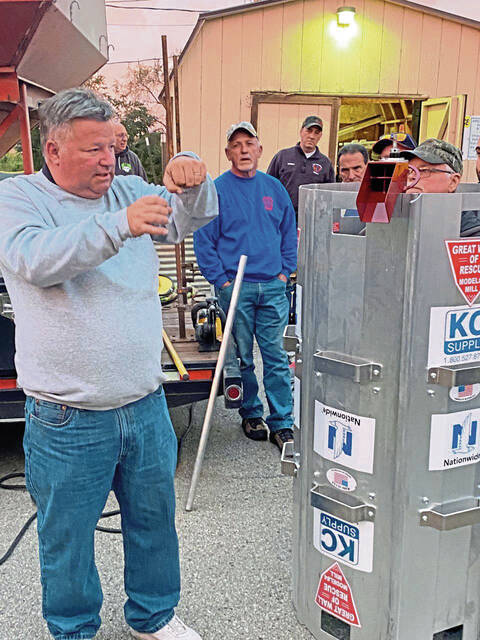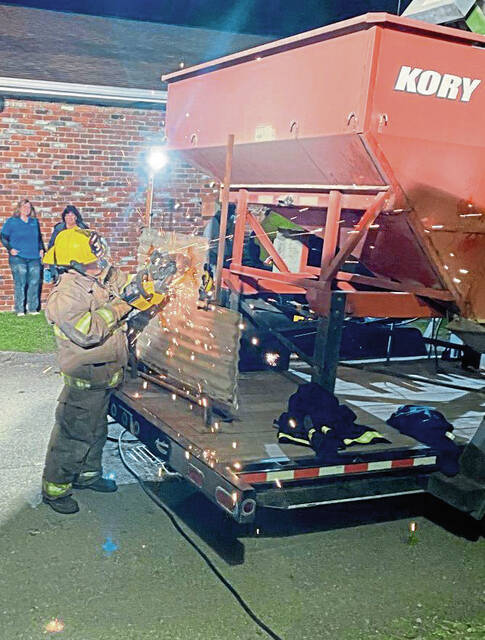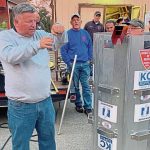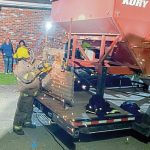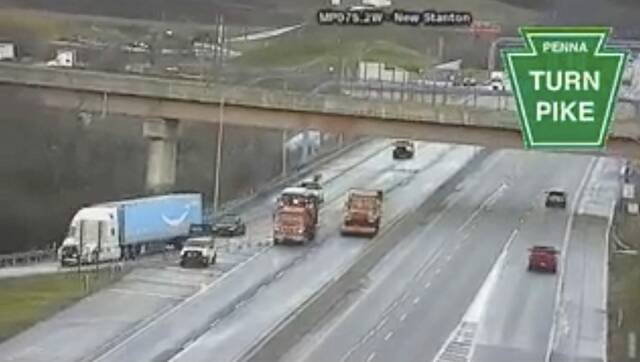If a farmer falls into a bin with flowing shelled corn, wheat, oats, sunflower seeds or barley, they might sink to their knees and be unable to free themselves in the time it took to read this sentence.
In as little as 20 seconds, an adult can be buried in the grain and has a slim chance of survival, according to an agriculture safety organization.
About 65 firefighters from 11 fire departments, including those in Unity, East Huntingdon, Fairfield, Hempfield, Ligonier and Penn townships, underwent training at the Pleasant Unity Fire Hall this week on how to free a person trapped in a bin so they and the farmer can get out safely.
The Pleasant Unity Fire Department received a metal rescue tube and an auger that removes the grain from inside through the support of Panichelle Insurance of Unity, the county farm bureau and Nationwide Insurance, in partnership with the National Education Center for Agricultural Safety in Poesta, Iowa.
Pleasant Unity was one of just seven fire departments in Pennsylvania to receive a bin rescue tube in a recent round of distributions to 58 fire departments nationwide.
John Bacha, Pleasant Unity fire chief, said he wanted to obtain a grain bin rescue tube because “there are a lot of specialty situations we run into, and rescuing a person trapped in a grain bin is one them.”
There are a number of farms in the area where the rescue tube could be used.
“It’s another tool in our toolbox to safely extricate someone in that situation,” Bacha said.
Pleasant Unity and Forbes Road are the only fire departments in the county that now have a grain bin rescue tube, Bacha said. The New Centerville Fire Department in Somerset County also has one.
Bob Rosatti, Forbes Road fire chief, said his department has never had to use the grain rescue bin since it acquired it about five years ago through assistance from the local farming community.
Rosatti said he will reach out to Bacha in an effort to conduct joint training on using the rescue bins to free a person trapped in a grain bin. If a grain bin entrapment does occur, Rosatti said, the two departments could jointly respond to the emergency.
In a simulated grain bin set up outside the fire hall, firefighters learned how to erect the 6-foot-tall metal panels that interlock to form the rescue bin and how to use the auger. It spits out the grain from inside the tube at 2½ bushels a minute to allow the victims to extricate themselves while keeping rescuers safe.
“It’s simple, but it’s ingenious,” Bacha said about the rescue bin and auger to remove the grain.
Metal stairs inside the rescue tube allows the victim to climb out of the bin, while rescuers stand outside the tube, standing on something akin to plastic holders for multiple bottles of soda pop to keep from sinking.
“Most people will get trapped once they sink above their knees, but most will get out once it is below their knees,” said Daniel Neenan, the trainer and director of the National Education Center for Agricultural Safety.
One of those who volunteered to be rescued, Cindy Funk, an agribusiness agent with Panichelle Insurance, said she felt trapped by the grain that came up to her waist.
“If you flexed your (leg) muscles, you could feel the corn. It got tight around the legs,” said Funk, who had selected Pleasant Unity as the home for the grain bin rescue tube.
The training on using the equipment was critical to freeing someone in constantly shifting grain, an experience that can be akin to being trapped in quicksand, said Bob Graham of Fairfield Township, president of the Westmoreland County Farm Bureau. Grain bins in the area can be 80 feet high and hold anywhere from 25,000 to 100,000 bushels of grain, Graham said.
“In a grain bin, there is nothing solid to stand on until you hit the floor, and that might be 30 feet below the level of the grain. Unless the first responders have the training, they won’t know how to use it (the rescue bin) efficiently or correctly,” Graham said.
First responders trying to rescue a trapped farmer have been killed.
There were 475 grain bin entrapments nationwide since 2007, according to the Great Plains Center for Agricultural Health in Iowa City, Iowa. Those could have been prevented if farmers simply abide by the warning painted on the domes of the bins — “Do Not Enter,” Graham said.
If they have to go into a bin, always have a spotter at the top of the bin and wear a harness that is attached to a pulley or bolt at the roof, Graham said.
“Entering a bin is a two-person job,” Neenan said. And if someone is trapped, Neenan said the best advice is to “call 911.”



